Category: Blessed Virgin Mary
Mary is the living house of the Lord, Pope recalls John XXIII 50th anniversary visit
On 4 October 1962,
Blessed John XXIII came as a pilgrim to this Shrine to
entrust to the Virgin Mary the Second Vatican Ecumenical Council, due to
begin a week later. On that occasion, with deep filial devotion to the Mother
of God, he addressed her in these words: “Again today, and in the name of the
entire episcopate, I ask you, sweetest Mother, as Help of Bishops, to intercede for me as Bishop of Rome and for all
the bishops of the world, to obtain for us the grace to enter the Council Hall
of Saint Peter’s Basilica, as the Apostles and the first disciples of Jesus
entered the Upper Room: with one heart, one heartbeat of love for Christ and
for souls, with one purpose only, to live and to sacrifice ourselves for the
salvation of individuals and peoples. Thus, by your maternal intercession, in
the years and the centuries to come, may it be said that the grace of God
prepared, accompanied and crowned the twenty-first Ecumenical Council, filling
all the children of the holy Church with a new fervour, a new impulse to
generosity, and a renewed firmness of purpose” (AAS 54 [1962], 727).
Our Lady of Walsingham
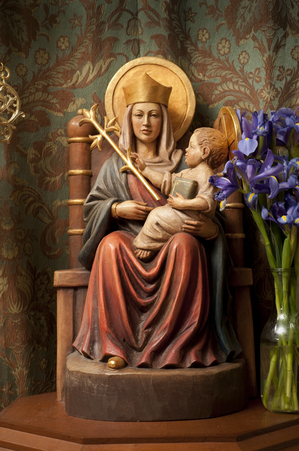 September 24th is the feast of Our Lady of Walsingham. She has had greater recognition in the past few years by Catholics in the USA due to an increased interest in ecumenism and the establishment of the personal ordinariats that offer Anglicans to come into full communion with the Catholic Church. The prayer, though, is prayer not just for ecumenism but for Our Lady to be present to us in mercy. We pray…
September 24th is the feast of Our Lady of Walsingham. She has had greater recognition in the past few years by Catholics in the USA due to an increased interest in ecumenism and the establishment of the personal ordinariats that offer Anglicans to come into full communion with the Catholic Church. The prayer, though, is prayer not just for ecumenism but for Our Lady to be present to us in mercy. We pray…O blessed Virgin Mary, Our Lady of Walsingham, Mother
of God and our most gentle Queen and Mother, look down in mercy upon us, our
parish [our monastery], our country, our homes, and our families, and upon all
who greatly hope and trust in your prayers, (especially…). By you it was that
Jesus, our Savior and Hope, was given to the world; and He has given you to us
that we may hope still more. Plead for us your children, whom you did receive
and accept at the foot of the Cross, O sorrowful Mother. Intercede for our
separated brother and sisters, that with us in the one true fold they may be
united to the Chief Shepherd, the Vicar of your Son. Pray for us all, dear
Mother, that by faith fruitful in good works we may be made worthy to see and
praise God, together with you in our heavenly home. Amen.
Our Lady of Mercy
Hail, Holy
Queen, Mother of Mercy, our life, our sweetness, and our hope. To you do we cry
poor banished children of Eve. To you do we send up our sighs, mourning and weeping
in this valley of tears. Turn then, O most gracious advocate, your eyes of mercy
toward us and after this our exile, show unto us the blessed fruit of your
womb, Jesus.
O clement! O loving! O sweet Virgin Mary!
The narrative of this feast of Our Lady has its origin in the devotion of Saint Peter Nolasco in the late 12th century France. Father Paul Haffner tells us more here.
The feast of Our Lady of Mercy is close to the heart of the Sisters of Mercy of Alma, and those who have an awareness of the role of Mercy in life.
May Our Lady of Mercy be with us, pray for us.
Our Lady of Sorrows
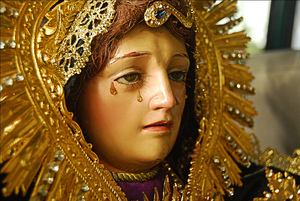 The Virgin Mary, who believed in the word of the Lord,
The Virgin Mary, who believed in the word of the Lord,
did not lose her faith in God when she saw her Son rejected, abused and
crucified. Rather she remained beside Jesus, suffering and praying, until the
end. And she saw the radiant dawn of His Resurrection. Let us learn from her to
witness to our faith with a life of humble service, ready to personally pay the
price of staying faithful to the Gospel of love and truth, certain that nothing
that we do will be lost.
The Most Holy Name of Mary
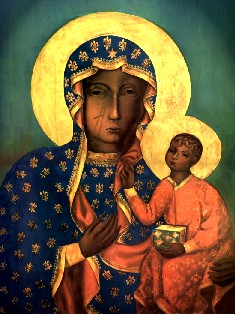 The Church has offered us a “Marian sandwich.” Let me explain. This week we are honoring the Mother of God with three distinct memorials: The Nativity of Mary (Sept. 8) and Our Lady of Sorrows (Sept 15) and today the commemoration of the Holy Name of Mary. In liturgical history this feast has been observed on various days before settling on this day. The feast was reintroduced to our Roman Missal by Pope John Paul II.
The Church has offered us a “Marian sandwich.” Let me explain. This week we are honoring the Mother of God with three distinct memorials: The Nativity of Mary (Sept. 8) and Our Lady of Sorrows (Sept 15) and today the commemoration of the Holy Name of Mary. In liturgical history this feast has been observed on various days before settling on this day. The feast was reintroduced to our Roman Missal by Pope John Paul II.
Nativity of the Blessed Virgin Mary
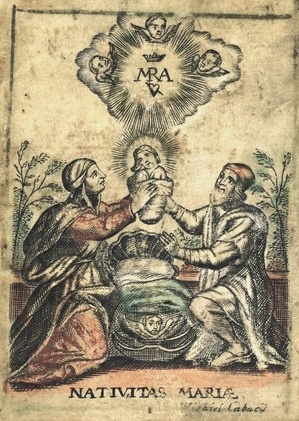 Let us celebrate with joy the Nativity of the Blessed Virgin Mary, for from her arose the sun of justice, Christ our God. (antiphon)
Let us celebrate with joy the Nativity of the Blessed Virgin Mary, for from her arose the sun of justice, Christ our God. (antiphon)
Impart to your servants, we pray, O Lord, the gift of heavenly grace, that the feast of the Nativity of the Blessed Virgin may bring deeper peace to those for whom the birth of her Son was the dawning of salvation.
Several things to pray for today,
- the Most Rev. Edoardo Aldo Cerrrato, CO, on the day of his episcopal ordination in Rome;
- the Cistercian Order;
- those who professed vows today;
- the Benedictines of Saint Mary’s Monastery (Petersham, MA);
- Archbishop Charles Chaput, OFM, Cap, on the first anniversary of being the archbishop of Philadelphia;
- Michael Maggiore who is healing.
Keeping in mind what Saint Thomas of Villanova reflected upon for today’s feast,
“What joy, what happiness there is in heaven! The shoot for the root of Jesse, sown so long ago in the patriarchs, has today sprung up and began to grow, and will bear a Flower which is destined to heal the world; a Flower whose scent revives the dead, whose taste heals the sick, whose beauty delights the angels; a Flower both white and red, which the angels long to see.”
Father Francis Weiser, S.J., in his The Holyday Book writes about today’s feast thus:
On Our Lady’s birthday the Church celebrates the first dawning of redemption with the appearance in the world of the Saviour’s mother, Mary.
The Blessed Virgin occupies a unique place in the history of salvation, and she has the highest mission ever commended to any creature. We rejoice that the Mother of God is our Mother, too.
Let us often call upon the Blessed Virgin as “Cause of our joy,” one of the most beautiful titles in her litany.
Since September 8 marks the end of summer and beginning of fall, this day has many thanksgiving celebrations and customs attached to it. In the Old Roman Ritual there is a blessing of the summer harvest and fall planting seeds for this day.
The winegrowers in France called this feast “Our Lady of the Grape Harvest”. The best grapes are brought to the local church to be blessed and then some bunches are attached to hands of the statue of Mary. A festive meal which includes the new grapes is part of this day.
In the Alps section of Austria this day is “Drive-Down Day” during which the cattle and sheep are led from their summer pastures in the slopes and brought to their winter quarters in the valleys.
This was usually a large caravan, with all the finery, decorations, and festivity. In some parts of Austria, milk from this day and all the leftover food are given to the poor in honor of Our Lady’s Nativity.
The 2010 post which includes a portion of a homily Saint Andrew of Crete is here.
Queenship of Mary
We, too,
approach thee to-day, O Queen; and again, I say, O Queen, O Virgin Mother of
God, staying our souls with our trust in thee, as with a strong anchor. Lifting
up mind, soul and body, and all ourselves to thee, rejoicing in psalms and
hymns and spiritual canticles, we reach through thee One who is beyond our
reach on account of His Majesty. (Saint John of Damascus)
… devotion to Our Lady is an important element
in our spiritual lives. In our prayer, let us not neglect to turn trustfully to
her. Mary will not neglect to intercede for us next to her Son. In looking to
her, let us imitate her faith, her complete availability to God’s plan of love,
her generous welcoming of Jesus. Let us learn to live by Mary. Mary is the
Queen of heaven who is close to God, but she is also the Mother who is close to
each one of us, who loves us and who listens to our voice.
Pope Benedict XVI
Queenship of Mary, 2012
Assumption of the Blessed Virgin Mary
 “those He justified, He also glorified” (Rom
“those He justified, He also glorified” (Rom
8:30)
of Mary from this world to the next. The Eastern Christians call today’s feast
the “Dormition,” the falling asleep of the Theotokos and the assumption to
heaven. In the West, we refer to this feast as the Assumption. That Mary,
without decay of the human, was called to heaven body and soul, by God.
Saint Mary of the Angels & The Portiuncula Indulgence
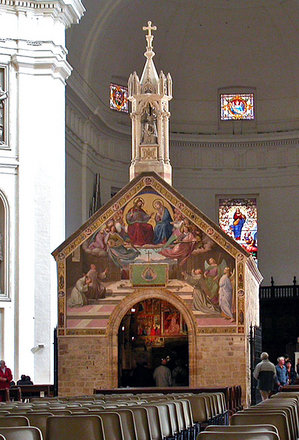 The spiritual tradition of the Franciscans is connecting the with the good work of the sainted founder, Saint Francis, who as you know, fixed three chapels: the third was called the Portiuncula (the Little Portion), dedicated to Saint Mary of the Angels. As you can see, the chapel sits in a large basilica in Assisi. The friars have been at the Portiuncula since early thirteen century. Saint Clare made her vows following Palm Sunday in 1212 and where Francis died on 3 October 1226.
The spiritual tradition of the Franciscans is connecting the with the good work of the sainted founder, Saint Francis, who as you know, fixed three chapels: the third was called the Portiuncula (the Little Portion), dedicated to Saint Mary of the Angels. As you can see, the chapel sits in a large basilica in Assisi. The friars have been at the Portiuncula since early thirteen century. Saint Clare made her vows following Palm Sunday in 1212 and where Francis died on 3 October 1226.
For centuries the Church, at the request of Francis, has attached a spiritual favor in the form of indulgence, a grant remission of sins to all who came there. It used to be given only at the Portiuncula but now the privilege extends beyond the Portiuncula especially those administered by Franciscans, throughout the world, to others churches as well.
The Church teaches that a plenary indulgence is a powerful tool for works of mercy and weapon in the living of the Christian life, that is, in our spiritual warfare. A plenary indulgence is the remission of the effects of sin, through the merits of Jesus Christ and the saints, through the Church, of all temporal punishment due to sin already forgiven through the reception of the sacrament of Confession.





